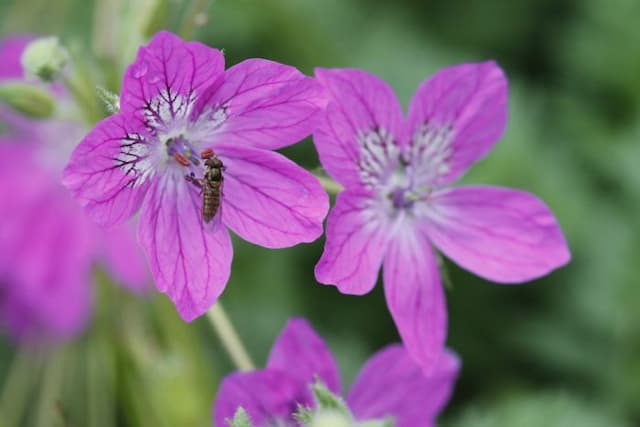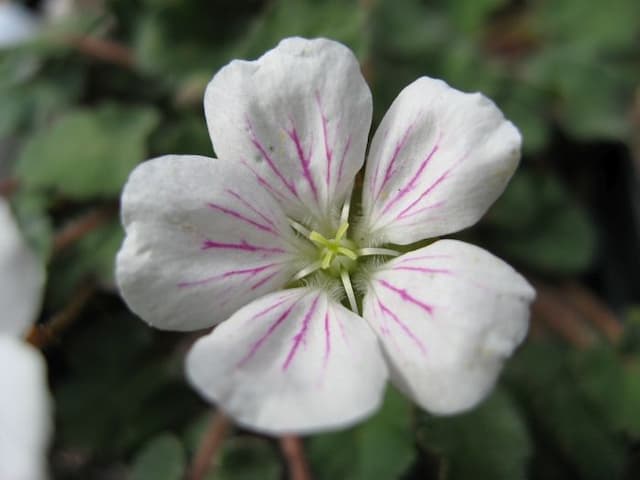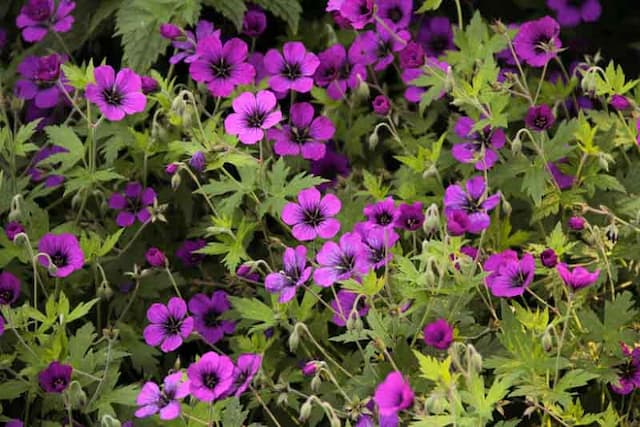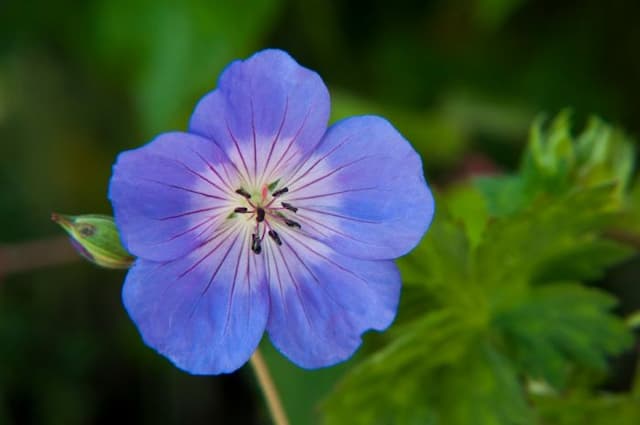Wood Cranesbill Geranium sylvaticum

ABOUT
Geranium sylvaticum, commonly known as woodland geranium, is a perennial plant that is known for its attractive appearance and resilience in shade. It has a clumping growth habit with lush, green, palmately lobed leaves that are softly hairy, giving them a somewhat velvety feel. Each leaf typically has five to seven deeply cut lobes. The woodland geranium blooms from late spring to early summer, producing clusters of striking flowers. These flowers are symmetrical and have five rounded petals that can range in color from light to deep violet blue, sometimes with delicate veining or a paler center. The floral display is vibrant and often attracts pollinators such as bees and butterflies. The plant also produces conspicuous seed pods that are beak-like in shape, adding further interest after the blooming period has ended. Overall, the woodland geranium presents a charming and cottage-like aesthetic, making it a popular choice for gardens and naturalized areas.
About this plant
 Names
NamesFamily
Geraniaceae.
Synonyms
Wood Cranesbill, Woodland Geranium, Forest Geranium.
Common names
Geranium sylvaticum L.
 Toxicity
ToxicityTo humans
Wood cranesbill, commonly known as Geranium sylvaticum, is not recognized for having significant toxicity to humans. In general, the plant is considered safe, and there are no commonly reported symptoms associated with poisoning from this species. Consuming any part of the plant is unlikely to lead to serious consequences, although individual sensitivities or allergic reactions can occur with any plant ingestion.
To pets
Wood cranesbill, or Geranium sylvaticum, is also not known to be toxic to pets. It is generally considered a non-toxic plant for animals such as dogs and cats, and there have been no significant or widespread reports of symptoms related to poisoning in pets from ingesting this plant. However, as with humans, individual pets may have varying sensitivities, and ingestion could potentially cause mild stomach upset in some cases.
 Characteristics
CharacteristicsLife cycle
Perennials
Foliage type
Deciduous
Color of leaves
Green
Flower color
Varies
Height
2 feet (60 cm)
Spread
1 feet (30 cm)
Plant type
Herb
Hardiness zones
2
Native area
Europe
Benefits
 General Benefits
General Benefits- Attracting Pollinators: Geranium sylvaticum, also known as Wood Cranesbill, is known for its ability to attract bees and other beneficial pollinators to a garden.
- Aesthetic Appeal: With its striking blue-violet flowers, Wood Cranesbill adds vibrant color and visual interest to landscaping.
- Erosion Control: This plant can help stabilize soil and prevent erosion due to its structure and root system.
- Habitat Restoration: It's often used in wildflower mixes for naturalizing areas, contributing to habitat restoration efforts.
- Low Maintenance: Wood Cranesbill is generally easy to care for, requiring minimal maintenance once established.
- Edible Parts: Some parts of the plant are considered edible and can be used in salads and as garnishes, though they are not widely consumed.
- Drought Tolerance: Once established, Geranium sylvaticum can tolerate periods of drought, making it suitable for xeriscaping.
- Seasonal Interest: Wood Cranesbill provides seasonal interest with its spring to early summer blooms, and sometimes a second flowering in the fall.
- Cultural Significance: In certain cultures, Wood Cranesbill is used in traditional events or ceremonies and is valued for its aesthetic properties.
- Wildlife Support: The plant is a source of nectar and shelter for various insects, contributing to a healthy ecosystem.
 Medical Properties
Medical Properties- Astringent: Geranium sylvaticum has been used for its astringent properties to tighten and tone tissues.
- Anti-inflammatory: Traditionally, it may have been used to reduce inflammation in various conditions.
- Antiseptic: The plant has been said to possess antiseptic properties that could prevent the growth of microorganisms.
- Diuretic: It has been suggested that Geranium sylvaticum might have diuretic effects, promoting the production of urine.
- Hemostatic: There is historical use of the plant for its hemostatic properties to stop bleeding.
- Vulnerary: The plant may have been utilized to aid in the healing of wounds by promoting cell growth and repair.
 Air-purifying Qualities
Air-purifying QualitiesThis plant is not specifically known for air purifying qualities.
 Other Uses
Other Uses- Geranium sylvaticum, commonly known as woodland geranium, can be used as a natural dye, producing a variety of colors ranging from grey to blue and purple when applied to textiles.
- The leaves of the woodland geranium are sometimes incorporated into potpourris for their subtle fragrance and are used to impart scent to linens and clothing.
- In some cultures, woodland geranium has been traditionally used to repel insects, with bouquets placed around the home to deter flies and mosquitoes.
- The petals of woodland geranium can be used in culinary decoration; they are sometimes crystallized or used fresh to adorn desserts and salads.
- The plant has applications in companion planting, as it is believed to help the growth of nearby plants by repelling pests and attracting beneficial insects.
- Woodland geranium can be planted to prevent soil erosion due to its hardy nature and ability to thrive in various soil conditions, thus stabilizing the soil with its root system.
- The vibrant flowers of the woodland geranium are sometimes used in floral arrangements and bouquets to provide a touch of wild beauty.
- During seasonal festivals or traditional ceremonies, the whole plant or its flowers may be used as a natural decoration due to their appealing appearance and association with woodland habitats.
- Crafters sometimes incorporate dried specimens of woodland geranium into decorative crafts, such as in homemade paper or botanical art.
- Some gardeners use the distinctive and ornamental foliage of woodland geranium as a background in shade gardens to highlight other plants with more vibrant colors.
Interesting Facts
 Feng Shui
Feng ShuiThe Wood Cranesbill is not used in Feng Shui practice.
 Zodiac Sign Compitability
Zodiac Sign CompitabilityThe Wood Cranesbill is not used in astrology practice.
 Plant Symbolism
Plant Symbolism- Protection: Geraniums have often been planted in gardens and around homes as a symbol of safeguarding the household against negativity and evil spirits.
- Friendship: The geranium is sometimes given as a gift to express esteem and deep friendship. It embodies the wish for good companionship.
- Health: Historically, geraniums have been associated with health and healing properties, conveying wishes for well-being.
- Fertility and New Life: Due to its abundant growth and propensity to replant easily, the geranium can symbolize fertility, rebirth, and the cycle of life.
- Peace or Tranquility: Geranium's soothing scent and beauty make it a symbol of a peaceful mind and serene environment.
 Water
WaterWood cranesbill, commonly known as Geranium sylvaticum, prefers moist but well-drained soil. It should be watered deeply once a week, providing about 1 inch of water each time, which equates to roughly 0.6 gallons per square yard. During hot, dry spells, water twice weekly. It's important to avoid overhead watering to prevent leaf spot diseases. Instead, water at the base of the plant early in the day to allow foliage to dry before evening.
 Light
LightFor Geranium sylvaticum, or wood cranesbill, the best lighting condition is partial shade, though it can tolerate full sun in cooler climates. The best spot for this perennial is where it can receive filtered sunlight or morning sun followed by afternoon shade. Too much strong sun can lead to scorching of the leaves.
 Temperature
TemperatureThe wood cranesbill fares best in temperature ranges between 60°F and 75°F but can survive minimum temperatures down to around 20°F. To thrive, it typically prefers the cooler temperatures of spring and fall and may go dormant in extreme heat above 85°F.
 Pruning
PruningPruning wood cranesbill involves deadheading spent flowers to promote continuous blooming and to maintain plant vigor. Pruning can be done throughout the blooming season as flowers fade. In early spring or after flowering, cut back the foliage to encourage a fresh flush of growth. The best time for major pruning is in late winter or early spring before new growth begins.
 Cleaning
CleaningAs needed
 Soil
SoilWood cranesbill, or Geranium sylvaticum, thrives in a soil mix that is well-draining, fertile, and humus-rich. The ideal pH for this plant's soil should be slightly acidic to neutral, ranging from 5.8 to 7.2. A good soil recipe could include equal parts of garden soil, peat moss, and coarse sand or perlite to ensure proper drainage and fertility.
 Repotting
RepottingWood cranesbill typically doesn't require frequent repotting. This plant should be repotted only when it outgrows its current container, which may occur every 2 to 3 years. During repotting, use the opportunity to divide the roots if the clump has become too large.
 Humidity & Misting
Humidity & MistingWood cranesbill prefers moderate ambient humidity levels but is quite adaptable and can tolerate some degree of variation. The best humidity level for this plant would mirror average room humidity, around 40-60%.
 Suitable locations
Suitable locationsIndoor
Place Wood cranesbill in bright, indirect light and have well-draining soil.
Outdoor
Plant Wood cranesbill in partial shade to full sun, with moist soil.
Hardiness zone
2-7 USDA
 Life cycle
Life cycleThe life of Wood Cranesbill (Geranium sylvaticum) begins as a seed, which germinates in early spring, emerging as a small seedling. The plant grows into a rosette of leaves, developing a deep taproot, and in its first year, it may not flower but rather focuses on establishing a strong root system. In subsequent years, the Wood Cranesbill grows taller stems and produces distinctive, deeply lobed leaves. Flowering typically occurs in late spring to early summer, showcasing its characteristic violet-blue flowers, which lead to successful pollination and result in the formation of distinctive beak-like seed capsules after fertilization. These capsules eventually dry and split open to disperse seeds, allowing for new plants to grow and perpetuate the cycle. In harsh conditions or during winter, the plant dies back to the ground, surviving as a rootstock to regenerate the following season.
 Propogation
PropogationPropogation time
Spring-Early Summer
The Wood Cranesbill, commonly known as Geranium sylvaticum, is typically propagated by seed. To propagate by seed, one should sow the seeds outdoors in fall, allowing them to go through a stratification period during the winter, which helps break the seeds' dormancy. In spring, the seeds will germinate as the temperatures rise. This approach leverages the natural cycle of seasons to prepare the seeds for sprouting, closely mirroring the process that occurs in the wild. It's a straightforward and effective way to propagate Wood Cranesbill, favoring its natural tendencies to ensure successful growth and reproduction.








![Cranesbill [Rothbury Gem]](/_next/image?url=https%3A%2F%2Fplants-admin.emdemapps.com%2Fimages%2Fplants%2F%2Fimages%2F604b6243984c2.png&w=640&q=75)
